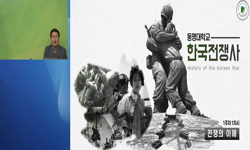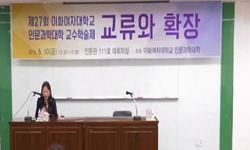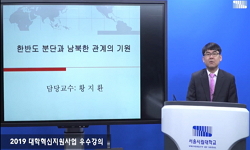(Abstract) In recent history education, interest in civic education has been increasing, and attention has been paid to the influence of the form and contents of exhibition narratives of museums or historical memorial facilities that are delivered to ...
http://chineseinput.net/에서 pinyin(병음)방식으로 중국어를 변환할 수 있습니다.
변환된 중국어를 복사하여 사용하시면 됩니다.
- 中文 을 입력하시려면 zhongwen을 입력하시고 space를누르시면됩니다.
- 北京 을 입력하시려면 beijing을 입력하시고 space를 누르시면 됩니다.
역사기념시설의 ‘한국전쟁’ 전시 서사 분석 : 외른 뤼젠(Jörn Rüsen)의 역사서사 유형을 활용하여 = The Analysis of the Narrative of the ‘Korean War’ Exhibition in Historical Memorial Facilities : With the historical narrative type of Jörn Rüsen
한글로보기https://www.riss.kr/link?id=T15655429
- 저자
-
발행사항
대구 : 경북대학교 교육대학원, 2020
-
학위논문사항
학위논문 (석사) -- 경북대학교 교육대학원 , 역사교육전공 , 2020. 8
-
발행연도
2020
-
작성언어
한국어
- 주제어
-
DDC
951.9 판사항(23)
-
발행국(도시)
대구
-
형태사항
ⅱ, 70 p. : 삽화 ; 26 cm
-
일반주기명
지도교수: 방지원
참고문헌 수록 -
UCI식별코드
I804:22001-000000097905
- 소장기관
-
0
상세조회 -
0
다운로드
부가정보
다국어 초록 (Multilingual Abstract)
In recent history education, interest in civic education has been increasing, and attention has been paid to the influence of the form and contents of exhibition narratives of museums or historical memorial facilities that are delivered to visitors in the context of citizens’ social memories and memory culture. Among the historical memorial facilities, war memorial facilities have great social influence. In particular, memories of the “Korean War” have been deeply involved in the historical consciousness and historical culture of members of post-war Korean society. Thus, the “Korean War” as a theme of history learning or exhibition has significant meaning in the context of history education oriented toward citizen education. With this in mind, this study analyzed the potential wartime history of The Warmemorial of Korea, Patriot and Peace Memorial, DMZ Museum, and War and Women’s Human Rights Museum focusing on the importance of the educational and social role of historical memorial facilities and the growing influence of the Korean War.
The theory of historical consciousness and type of narrative (traditional type, typical type, critical type, and genetic type) of Jörn Rüsen was borrowed to analyze the exhibition narrative of the historical memorial facilities. Using Rüsen’s historical consciousness as a tool to analyze the history of the Korean War, Rüsen analyzed the exhibition narratives of each historical memorial facility by linking the past to the present and the future in a way that embodies the past. After reviewing and analyzing the large narrative of the exhibition and the ‘Narrative abbreviation’, historical memorial facilities showed overlapping narrative and historical consciousness types. Meanwhile, traditional and typical types of wartime narratives stood out at the War Memorial of Korea and Patriot and Peace Memorial. In particular, the Patriot and Peace Memorial wanted to convert traditional and typical narratives into memories for local identity. The War and Women’s Human Rights Museum showed critical and genetic exhibition narratives from the perspective of approaching the 'war' itself, although it is not a memorial facility directly related to the Korean War. While revealing typical and traditional war narratives and their corresponding historical consciousness, the DMZ Museum attempted various angles of narrative, conscious of critical discourse.
We learn history and try to understand the direction of our lives through understanding history. As historical memories are valued, the impact of memories other than textbooks on our perception of history is growing. The memory of war is stronger in that character. In particular, war memories by monuments are typical. Since it is an interface between knowing about war and learning how to remember war, it is necessary to think about the historical educational meaning of developing the power to analyze the exhibition history of historical memorial facilities.
(Abstract)
In recent history education, interest in civic education has been increasing, and attention has been paid to the influence of the form and contents of exhibition narratives of museums or historical memorial facilities that are delivered to visitors in the context of citizens’ social memories and memory culture. Among the historical memorial facilities, war memorial facilities have great social influence. In particular, memories of the “Korean War” have been deeply involved in the historical consciousness and historical culture of members of post-war Korean society. Thus, the “Korean War” as a theme of history learning or exhibition has significant meaning in the context of history education oriented toward citizen education. With this in mind, this study analyzed the potential wartime history of The Warmemorial of Korea, Patriot and Peace Memorial, DMZ Museum, and War and Women’s Human Rights Museum focusing on the importance of the educational and social role of historical memorial facilities and the growing influence of the Korean War.
The theory of historical consciousness and type of narrative (traditional type, typical type, critical type, and genetic type) of Jörn Rüsen was borrowed to analyze the exhibition narrative of the historical memorial facilities. Using Rüsen’s historical consciousness as a tool to analyze the history of the Korean War, Rüsen analyzed the exhibition narratives of each historical memorial facility by linking the past to the present and the future in a way that embodies the past. After reviewing and analyzing the large narrative of the exhibition and the ‘Narrative abbreviation’, historical memorial facilities showed overlapping narrative and historical consciousness types. Meanwhile, traditional and typical types of wartime narratives stood out at the War Memorial of Korea and Patriot and Peace Memorial. In particular, the Patriot and Peace Memorial wanted to convert traditional and typical narratives into memories for local identity. The War and Women’s Human Rights Museum showed critical and genetic exhibition narratives from the perspective of approaching the 'war' itself, although it is not a memorial facility directly related to the Korean War. While revealing typical and traditional war narratives and their corresponding historical consciousness, the DMZ Museum attempted various angles of narrative, conscious of critical discourse.
We learn history and try to understand the direction of our lives through understanding history. As historical memories are valued, the impact of memories other than textbooks on our perception of history is growing. The memory of war is stronger in that character. In particular, war memories by monuments are typical. Since it is an interface between knowing about war and learning how to remember war, it is necessary to think about the historical educational meaning of developing the power to analyze the exhibition history of historical memorial facilities.
목차 (Table of Contents)
- Ⅰ. 서론 1
- 1. 연구의 목적과 필요성 1
- 2. 연구 내용과 방법 4
- Ⅱ. 역사기념시설 전시 서사 분석을 위한 이론적 검토 8
- Ⅰ. 서론 1
- 1. 연구의 목적과 필요성 1
- 2. 연구 내용과 방법 4
- Ⅱ. 역사기념시설 전시 서사 분석을 위한 이론적 검토 8
- 1. 역사기념시설 전시 서사의 교육적 의미와 중요성 8
- 2. ‘전쟁 기억’과 ‘한국전쟁’ 서사의 양상 15
- 3. 서사 분석 도구로써 뤼젠의 역사의식과 역사적 서사 유형 21
- Ⅲ. ‘한국전쟁’ 전시 서사 분석 32
- 1. 전쟁기념관 32
- 2. 호국평화기념관 41
- 3. DMZ박물관 48
- 4. 전쟁과 여성인권 박물관 53
- Ⅳ. 결론 58
- 참고문헌 62
- Abstract 69












